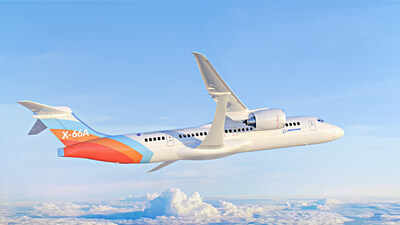U.S. Airlines to Support NASA-Boeing Sustainable Flight Demonstrator Project
- U.S. airlines to provide input on operational efficiencies, maintenance, handling characteristics, and airport compatibility for the X-66A project.
- X-66A will test Transonic Truss-Braced Wing (TTBW) airframe configuration to achieve net-zero aviation greenhouse gas emissions.
- A single-aisle airplane with TTBW configuration could reduce fuel consumption and emissions up to 30% relative to today's domestic fleet of airplanes.
- None.
Insights
Analyzing...
NASA and Boeing also unveiled the new X-66A livery today at EAA AirVenture Oshkosh.
"Hearing directly from the operators during all phases of the Sustainable Flight Demonstrator project will help us understand exact requirements and tradeoffs," said Todd Citron, Boeing chief technology officer. "The airlines' feedback will significantly contribute to the X-66A project learnings while furthering aviation sustainability."
The X-66A will test the Transonic Truss-Braced Wing (TTBW) airframe configuration and will be built from a modified MD-90 aircraft at a Boeing facility in
When combined with expected advancements in propulsion systems, materials and systems architecture, a single-aisle airplane with a TTBW configuration could reduce fuel consumption and emissions up to
The
- Design: Airline participants will share feedback on sustainable operations and airport compatibility. While the X-66A will have a wingspan of 145 feet, the TTBW design could be used by airplanes of different sizes and missions and may benefit from folding wing tips to accommodate existing airport infrastructure.
- Simulation and lab testing: Airline pilots will have a chance to experience the X-66A through a flight simulator and assess the vehicle's handling characteristics.
- Flight testing: Airline operations and maintenance teams will assess the X-66A as modifications are made to the airplane. Flight testing is slated for 2028 and 2029 out of NASA's Armstrong Flight Research Center at Edwards Air Force Base.
As a leading global aerospace company, Boeing develops, manufactures and services commercial airplanes, defense products and space systems for customers in more than 150 countries. As a top
Contact
Boeing Media Relations
media@boeing.com
![]() View original content to download multimedia:https://www.prnewswire.com/news-releases/us-airlines-to-support-nasa-boeing-sustainable-flight-demonstrator-project-301885246.html
View original content to download multimedia:https://www.prnewswire.com/news-releases/us-airlines-to-support-nasa-boeing-sustainable-flight-demonstrator-project-301885246.html
SOURCE Boeing








